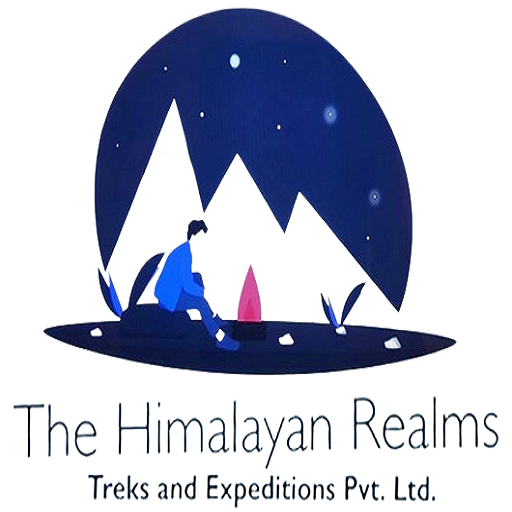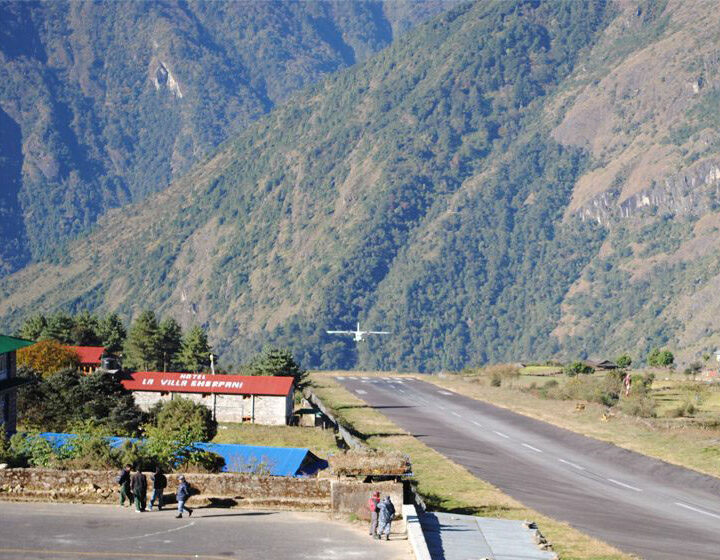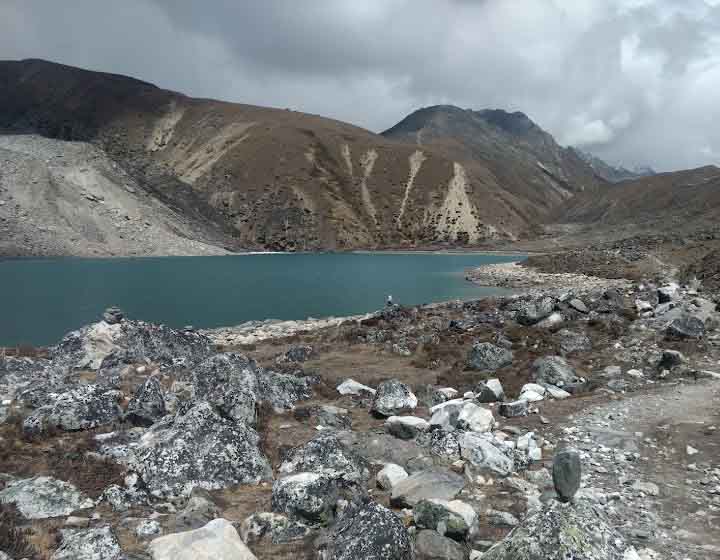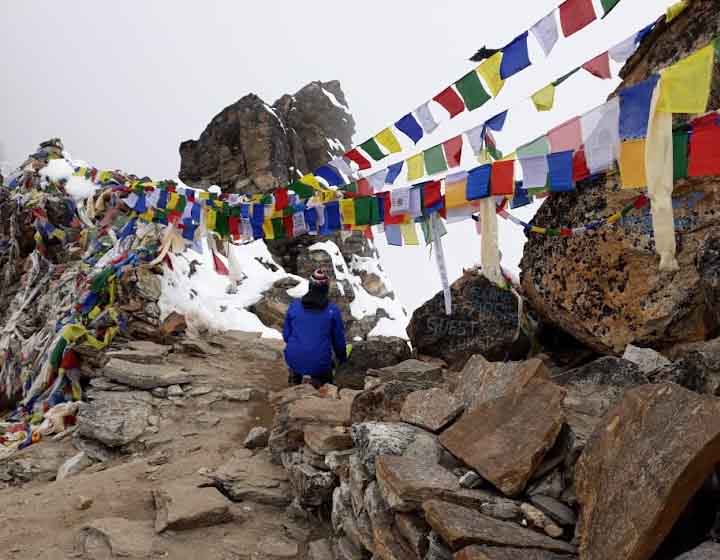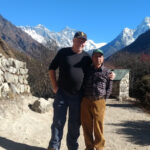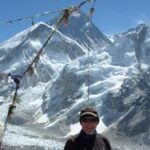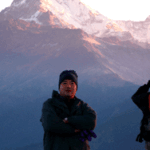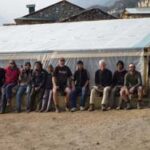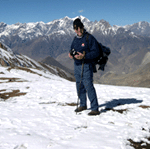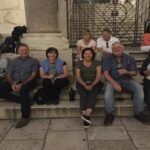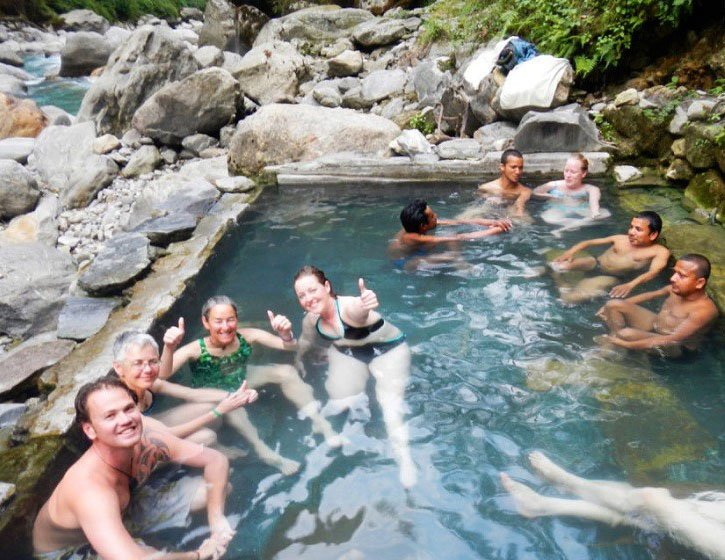
Trip overview
Bhurung khola hot spring is a village development committee in Nepal’s Dhaulagiri Zone, specifically in Myagdi District. The name “Tatopani” means “hot water” in Nepali, referring to the area’s well-known natural hot springs. The Bhurung Khola hot spring is geothermal springs, drawing both residents and visitors looking for relief from ailments like joint pain, skin conditions, and stomach problems.
The hot spring complex consists of three pools of varied sizes, which may accommodate up to 300 bathers at once. During peak seasons, daily visitors range from 500 to 1000 people. The best time to visit the region is between September and April, when the temperature is milder. Access to the pools costs NPR 150 per person.
Geographically speaking, Bhurung Tatopani is Located roughly 9 kilometers from Beni, the district headquarters of Myagdi, and approximately 297 kilometers from Kathmandu. The settlement is located on the banks of the Bhurung Khola (river), with the beautiful Annapurna mountain range providing as a scenic backdrop. Its strategic location makes it a popular stopover for trekkers trekking the Annapurna Circuit and other surrounding paths.
In addition to its natural hot springs, Bhurung Tatopani allows guests to experience traditional Nepali village life. The local community is famed for its friendly friendliness, and the area offers possibilities for cultural exchanges, tasting local cuisine, and exploring adjacent natural sights.
For those planning a trip, hotels range from simple lodges to more comfortable guesthouses. It is recommended to examine the current state of facilities. Assess road conditions ahead of time, particularly during the monsoon season, because weather-related difficulties might have an impact on infrastructure.
Overall, Bhurung Tatopani provides a distinct combination of natural beauty, cultural richness, and therapeutic relaxation, making it a standout destination in Nepal’s diversified geography.
Main highlight:-
Natural Hot Spring Waters:
The hot spring is known for its warm, mineral-rich waters, which are believed to have healing properties for skin ailments and body aches. Visitors can relax and rejuvenate in the soothing water.
Picturesque Location
Situated near the Bhurung Khola River, the hot spring is surrounded by lush greenery, serene landscapes, and views of the Annapurna mountain range. The tranquil environment makes it a peaceful retreat.
Ideal Rest Spot for Trekkers: Bhurung Khola Hot Spring is often a stop for trekkers on the Annapurna Circuit Trek or nearby routes. It’s a perfect place to relax sore muscles after a long day of trekking.
Cultural Significance: The hot spring holds significance for local communities, who consider it a natural gift.
Accessibility: While relatively remote, the hot spring is accessible via trekking routes and is an exciting part of the adventure in the Annapurna region.
Peaceful Atmosphere
Hot spring is Unlike more commercialized but Bhurung Khola Hot Spring is retains its natural and untouched charm, making it a favorite for those seeking solitude in nature.
Similarly, Himalayan Realms Treks offers a wide range of trekking routes in the Annapurna region, including both classic trails and off-the-beaten-path adventures. Moreover, these routes cater to trekkers of all skill levels, from beginners seeking a short and scenic trek to experienced hikers looking for a challenging expedition. In addition, the breathtaking landscapes, diverse cultural experiences, and well-established trekking infrastructure make the Annapurna region an ideal destination for adventurers. Below are some of them for your information.
Siklish Trek 9 days
Kathmandu Chitwan & Pokhara Tours 7/8 Days
Australian camp Tour Nepal for 6 days
Khayar Lake Trekking 17 days
Panchase Trekking 7 days
Kathmandu,Pokhara and Sarangkot Tour (6 days)
Dhampus, Sarangkot Trek 8 days
Jomsom Muktinath Trek, 13 days
Annapurna circuit Trek, 12 days
Mardi Trek 6 days
Itinerary
After arrival in Kathmandu International airport, you will be welcomed by our staff and he will assist you to transfer the hotel. At hotel he gives you orientation of the overall trip. Meet your trekking guide. On at hotel in Kathmandu.
Full day sightseeing in Kathmandu valley inclusive of Buddhanath Stupa, (one of the biggest Buddhist stupa in Nepal, where also you will be able to see many monks and Tibetan peoples), Pasupatinath (one of the most important Hindu Temple of God Shiva, where dead body also cremate), Bhaktapur City (Among three oldest cities is one of the interesting city, where visitor can see fifty five wood carving windows palace, a lot of pottery clubs, many temples and a lot of wood carving place), Patan City (Also one of the city like Bhaktapur where you will be able to see a HinduTemple call God Krishna Temple and Many others as well as A Buddhist Temple call Golden Temple ) & Swyambhunath Stupa (One of oldest Buddhist Stupa situated at the highest place in Kathmandu Valley, from where you can see the scenery of Kathmandu Valley, as well as some mountain peaks also if weather is nice)
Wake up early in the morning. Have a breakfast at the hotel. Walk to Tourist bus station bout 10-15 minutes with your trekking guide. Tourist bus departs for Pokhara at 7 o’clock. Enjoy seven our scenic drive. The bus stops half an hour nearby highway restaurants on the way for lunch. You will be reached at Pokhara around 2 o’clock. Check in at Pokhara hotel. The rest of the day is free. O/n at hotel in Pokhara
After breakfast, take one hour drive to Nayapul. After you reach Nayapul, you will start your trekking slowly. After 20-minutes walking along the Modi stream, you will reach at Birethanti – a beautiful village that has plenty of tea shops and guest houses. Then follow the left route through the village. Your trek continue heading to Ulleri following the bank of the Burungdi stream. You will climb slightly up to the valley of Hile (1495 meters) and Tikhedhunga (1525 meters). The trail leads steep up to Ulleri (2073 meters), a large beautiful Magar village. Ulleri is stopping point for today. in the mountain area of Ullery.
After breakfast you start your walking. Today the trail leads you to the Ghorepani, one of the popular destinations of Annapurna region situated at an altitude of 2856 meters. You should gently ascend up to Banthanti (2250 meters) through Oak and rhododendron forest. Then continue trek towards Ghorepani through Nangeythanti (2460 meters). Today you will walk approximately 5 hours. O/ n at mountain lodge
Day 06:- Early in the morning climb up to Poon Hill (3210 meters) to see the panoramic views of Annapurna, Dhaulagiri, Lamjung Himalayan ranges as well as exciting sunrise view over the Himalayas. After experiencing the great views of Himalayan panorama from Poon Hill, you descend to Ghorepani.After breakfast, continue downhill trek to Tatopani . The trail goes along the ridges of rhododendron and pine forest till the Tatopani bank of the Kaligandaki. O/ n at mountain lodge
Day 06:- Early in the morning climb up to Poon Hill (3210 meters) to see the panoramic views of Annapurna, Dhaulagiri, Lamjung Himalayan ranges as well as exciting sunrise view over the Himalayas. After experiencing the great views of Himalayan panorama from Poon Hill, you descend to Ghorepani.After breakfast, continue downhill trek to Tatopani . The trail goes along the ridges of rhododendron and pine forest till the Tatopani bank of the Kaligandaki. O/ n at mountain lodge
The new motor road access to the Beni, those short of time to make dramatic and at times unnerving exit down the Kali Gandaki to Beni. It is large rapidly expanding trading town.
From Tatopani few minutes drive three is great view of Fang and ahead is a spectacular narrow defile where the Kali Gandaki is almost choked off. Drive through the Tipyang 1040 m, offers basic lodge and refreshment, continuous drive Beg Khola valley and forever on to Galeshwar and Beni 830m. Explore the Beni Bazaar.Pohara road is still not sealed as far as the baglung turn-off , a rough 40m drive. From Kushma the driving is smooth and good road to Pokhara.
After breakfast walk to tourist bus station with trekking guide. Then set for Kathmandu. After reach in Kathmandu, you will be taken to your hotel at Kathmandu. Have a rest. In evening you can stroll around Thamel, the major tourist destination of Kathmandu. You can do some last minute shopping of souvenirs for your family and relatives. O/n at hotel in Kathmandu
Today is your the last day in Nepal. Our officer will come to meet you at the hotel to escort you to Kathmandu International Airport for your flight to home.
